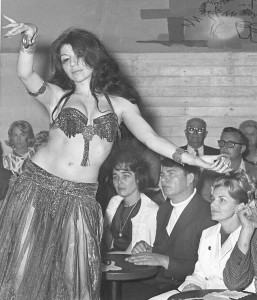
Ever wonder what a lifetime of belly dance will do for your body? Aisha Ali started dancing fifty-four years ago in 1961. She scheduled our interview around getting estimates from various roofers and needed time to climb onto the roof with each of them to point out what she wanted. So, yes, a lifetime of dance will improve your flexibility, grace and, apparently, balance.
I know Aisha primarily from the pages of “Habibi Magazine.” When I started dancing, there were only a handful of online Belly dance sites, so each magazine was a cherished opportunity to learn about dancing around the United States and internationally. I’d sit down and read the magazine from cover to cover, but the memories that most stick out are the black-and-white pictures of Aisha in intense poses as well as the excellent quality of her scholarship. Neither prepared me for the bubbly and passionate person on the other end of the phone line. Aisha is a delight. Go study with her. Just go.
Aisha tells me she’s been hard at work on a book of her memoirs, so what follows is the briefest of appetizers for the feast that is to come.
(Below: Aisha Ali dances in an episode of the TV show “The Girl from U.N.C.L.E”)
Believe in yourself
Aisha’s career is marked by belief and confidence — and a fair amount of luck.

During the early 1960s, Aisha was studying drama with Rick Walters at the Theatrecraft Workshop in Hollywood and her scene partner was this guy (the one playing Dracula at right). Yes, she and Frank Langella were studying together during a period when Frank came from New York to check out Los Angeles. It was Langella who told her, “With such long legs, you should be a dancer.” When a boyfriend gave Aisha his fencing credits from The Nico Charisse School of Dance, she was hoping to take belly dance. They didn’t include it, so she settled for “primitive” dance with Ellie Johnson, a Katherine Dunham dancer.
“Frank and I wanted to give a party but didn’t have much money so we invited people and told them to bring food and drinks. We bought a record by Karaman called “The Flames of Araby” and I entertained with my so-called exotic belly dance. It was all phony baloney, but we were both very young and believed in ourselves.”
As luck would have it, the following year, Aisha was working as a part-time draftsperson and was invited to a party of mostly engineers where she met George Rabe, the president of UCLA’s Arab Student Group. He invited her to the school’s international festival and said that the Arab students were presenting a belly dancer. When Aisha informed him that she was a belly dancer he promptly asked her to perform. She hesitantly agreed only after he told her she would be the star.
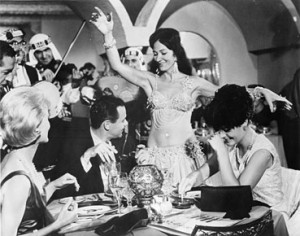
Actually Aisha had never even seen a belly dancer, but after consulting her aunt, she and her mother went to The Fez to watch one. Unfortunately, they didn’t consider the dancer’s schedule, so they didn’t get to see a dancer, but many of the Arab students who hung out there danced with Aisha and told her she was great, so she decided, “OK, I’m good. I don’t need to see a dancer”. Fortunately a week later, George Rabe called to invite her to see Zanouba, a dancer from Egypt, who would be performing for a Hafla at St. Nicholas Church. This is when Aisha saw her first authentic belly dancer. “The bare-midriff was shocking to me, but not in a bad way. I was struck by how statuesque and elegant Zanouba was – all fresh and perfumed with a smile that invited the audience to be part of her performance.”
Costume design
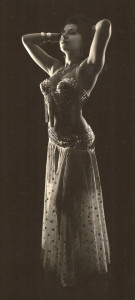
After renting a vintage costume with some pantaloons worn by Betty Grable in an “On the Road movie,” Aisha first performed a week before the festival at the Religious Conference Building on campus. By the festival performance, at Sproul Hall, she and her mother had quickly pulled a costume together: “Black chiffon panels and a silver brocade belt that stuck out in the back like a ducktail. The bra had a few beads dangling from it.” She used the “Flames of Araby” record and danced to two selections. The audience found it curious that she kept dancing during the blank space between the tracks.
The other dancer was Leona Wood who would become Aisha’s closest friend and mentor. Aisha was impressed by Leona’s costume and complimented her on it. Leona smiled and replied “Well after all, the difference between three months and one week of work,” pointing to Aisha’s. “At the beginning, I must admit that it’s the costumes that lured me to become a professional dancer. I was motivated to learn how to design, cut, sew and bead,” Aisha says.
With few other dancers around, Aisha was quickly in demand. Very soon she was making more money dancing than working as a part-time draftsman, so she gave up her job and became a full-time dancer.
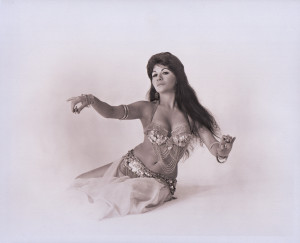
Pay and working conditions

Her very first job was in Fresno dancing at The Bagdad, where she brought home $50 for the weekend ($395.65 in 2015 dollars) plus tips. Her next job at The Torch club in Hollywood brought home $15 a night for two 15 minute sets – that’s $118.70 in 2015 dollars. Her starting salary at the Greek Village was $15 for one dance, but when not dancing she had to sit on stage with the musicians and singers and play cymbals all night. At The Fez she earned $25 each night for three long dances. Dancing at parties or “haflas” for Mustafa Akaid and the Arab community, typically paid between $30 and $50. In the beginning, she worked about four nights a week. Later, she had contracts in San Diego, Vegas, and London, where she danced every night.
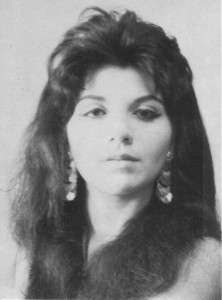
Aisha had also joined Leona Wood’s dance company, which was to become AMAN International. In addition to fine art oil painting, she learned much from Leona about design, music, and lighting. Since belly dance wasn’t Leona’s primary love, Aisha learned that from watching other dancers. In addition to the Egyptian dancers in Los Angeles, Maya Medwar and Zanouba, she also learned from dancers visiting from the East Coast: Turkish dancers like Soroya Melik and Princess Ayshe. Then there was Marlene of Cairo, aka Marlena Adamo from Brazil by way of New York, who traveled with her scrapbooks and press releases about her career as a ballerina. Marlena was so good technically that she could work in any club she chose for the highest earnings. Several times she fixed it so that Aisha would get her job with the Marlena-earnings by “suddenly” leaving the club owners in the lurch, after providing young Aisha as a substitute. In San Francisco Aisha worked with two Algerian sisters known as Soroya and Fatima Ali, and was influenced by American dancers like Jamila and Dahlena, whom she lived with for a short time.
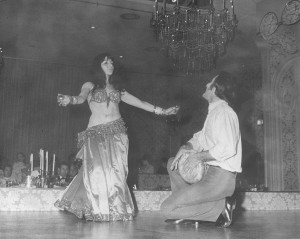
But it wasn’t all great money and live music. At The Torch Club on Hollywood Blvd, Aisha found herself working for a Greek woman named Helen Capello who imported gypsy musicians from Greece: “She would provide their airfare, room and board and they worked for tips and stayed as long as their visa would allow. When they left Capello would import a new group.”
“Most customers smoked cigars and drank Metaxa and tipping was done differently back then. The Torch was frequented by older Greek, Turkish and Armenian men who would spit on silver dollars and paste them on my forehead or chest. And Madame Capello was often slow about paying me.”
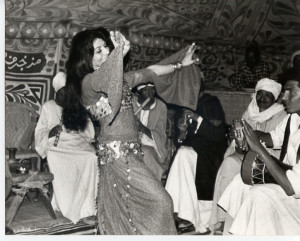
Traveling to the Middle East
During the 1960s while studying ethnomusicology at UCLA, Aisha enjoyed full access to the archives and had “fallen in love with the folk music of Upper Egypt.” For nearly 10 years, she used the field recordings of Hans Hickman, Tiberiu Alexandrou and Fumio Koizumi, to teach Ghawazi style to the music of the Banat Mazin whom she would later perform with, film, record, and write about. Eventually, Aisha felt the urge to go to the Middle East herself and “find the roots of the dance.” (NOTE: Aisha has used the 19th-century British spelling “Ghawazee” in all her published works since 1971 when she borrowed it from her sources. Although the term literally means “invaders,” it was a name given to certain Egyptian dancing girls. Since Ghawazee were virtually unknown in most circles before Aisha introduced them, there was no other spelling in use. Today some western scholars prefer to use the spelling “Ghawazi.” The feminine singular would be “Ghaziya” and the masculine singular would be “Ghazi.”)
During her first trip in 1971, Aisha says she observed various Gypsy entertainers but didn’t find the group she was searching for. Notes with the field recordings hadn’t provided the dance group’s name. “In those days, many non-Arab scholars didn’t understand that the term Ghawazee usually referred to Gypsies.” Aisha tried to explain who she was looking for, but her Arabic was limited and those that did understand her, didn’t consider the entertainers she was looking for as “desirable.”
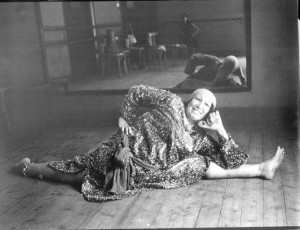
Due to the Arab-Israeli War, her travel was confined to main roads. At that time, she regularly attended classes with the first Egyptian National Dance Company, the Reda Troupe. She was dependent on Mahmoud Reda who brought Nezla Al Adel (left), a ghaziyeh from Mansoura to his studio so that Aisha could learn from her. He also arranged for Samia Gamal to come and coach her. Travel in the Middle East was significantly different from what it is now. There were no large dance festivals in those days and she didn’t go with a tour or a group of her pals. She went alone, often relying on letters of introduction and luck to make her way. With a dance company and a Beverly Hills boutique at home, Aisha could only remain abroad for a month or two at a time.
In 1973, while staying with an Armenian family in Cairo, she finally learned the actual identity of the particular group of Ghawazi she wanted to find. They told her to seek out a group called the “Banat Mazin” and that they lived near Luxor. While buying a ticket to Luxor Aisha told the travel agent her reason for going to Upper Egypt and he suggested she contact the agent El Baron, who was often used by film studios for arranging entertainers and licenses. When she mentioned Baron to Mahmoud Reda, he advised her against making the contact, explaining that the man had a colorful reputation.
Before leaving for Upper Egypt, Mahmoud wrote a letter of introduction for Aisha, who barely understood what was written given her limited Arabic, but generally it said: “This is my friend Aisha Ali who is a teacher and respectable woman. Please assist her in locating the musicians and dancers she seeks.”
When Aisha reached Luxor, she got off the airplane and couldn’t find her luggage. As she continued circling the small airport, a man kept following her and asking if he could help. Accustomed to being pestered in Cairo, she was rude to him but finally broke down and complained that she couldn’t find her luggage. The man wanted to know who her guide was and Aisha didn’t have one but since he seemed to feel that a guide was a necessity, she gave him the name “El Baron.” He was taken aback and responded with “Why didn’t you say so?” Quickly he located and removed her luggage from a waiting tour bus and insisted she get in his private “limo”, after which he drove her to the Winter Palace where her “guide” was waiting to meet her in the lobby.
Without removing his sunglasses, El Baron, gave her a scrutinizing look, and asked how he could help her. She mentioned the Banat Mazin and then had the inspiration to hand him Mahmoud’s letter. He took the letter and appeared to be reading it, then excused himself for about 45 minutes.
When he returned, he assured Aisha that he would take care of everything and told her to go to her room to rest and meet them later around 6pm at the ferry landing. He advised her to wear a baladi toub covered by a gallabeya.
Aisha explained that she couldn’t afford to stay at the Winter Palace, but he told her “everything was taken care of.”
That night, at the landing, Aisha met the Banat Mazin and Abu Kharage’s mizmar group. The entertainers boarded a river boat and performed together for a group of French tourists. “I watched and followed the dancers and instantly adapted to their loose choreographies. It was easy because I had been dancing to their music for 10 years.” Once the French tourists were dropped back at the dock, they returned to the Nile and floated with the engine turned off while Aisha recorded the music.
El Baron turned out to be rather wonderful and they became great friends. “He was the only person I met in all of Egypt who had a similar passion for the music,” Aisha says. After that night, he booked her for weddings, festivals and parties and whenever she worked with the Banat Mazin, she was able to film them and record the musicians. This continued over a period of more than 25 years whenever she came to the Luxor area.
“At first the other dancers tolerated me, like having an odd duck in their midst,” Aisha says. Over time, Aisha’s costumes may have influenced the Banat Mazin. “Traditionally they wore wide fringed skirts overlaid with panels of coins, and hip padding under the skirts that lifted them and made them swing better. By 1977, they had also begun performing in straight tobes. Later, once the fringe skirts wore out and they sold them, I don’t think they ever went back to that style but it was a great costume, that really moved.” They were curious and sometimes competitive with Aisha, especially when performing for European tourists, but the competition didn’t extend to when Aisha performed raqs sharqi, the Egyptian form of belly dance developed during the early part of the 19th century and seen in countless Egyptian films from the Golden Era. “They were very firm about not performing raqs sharqi because although they were known courtesans, they considered the dance to be indecent,” Aisha says. When their cousin Shadiya went to Paris with Mohamed Murad’s group and performed raqs sharqi, they were outraged.
“Because they respected El Baron, they learned to accept me and I helped make them famous by writing about them and publishing the music. Prior to that, it was mainly the Fellahin in Upper Egypt who knew of them. Over the years, their tolerance of me turned into affection, and certainly, I have always loved them, especially Khyria who was performing even after marriage and was usually my dance partner.” Aisha says.
Ouled Naïl
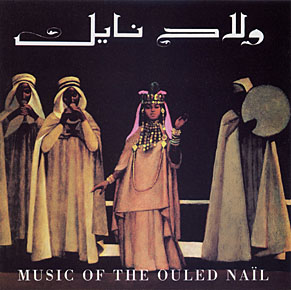
In 1973, Aisha hauled her equipment into the desert to visit the Ouled Naïl, no small feat given that it was 120 degrees in the shade. “It was so hot you could hear the heat buzz.” At a rug festival near Chellala, the dancers performed in tents. Their feet kicked up sand and the steam from the brewing tea mixed with the dust.
“Their moves were limited but specific. Most typical was the strong control of the pelvic region, which they borrowed from the Ottoman Turks and is still seen in Turkish dance. The defining technique is in the bouncing belly, up and down, lift and drop, then side to side and up and down with fast shoulder shimmies.” The dancers wore layers of dresses made from semi-sheer shadow cloth fabrics.
“It was hypnotic,” she says. “The bendirs with snares created a deep buzzing tone that echoed the environment. This was accompanied by goatskin bagpipes played by musicians using circular breathing so they could continue on without stopping for fresh breath.
“The woman were wearing the same gowns that I later saw worn in a French travel film made in 1937. They had given me a gown that was identical.”
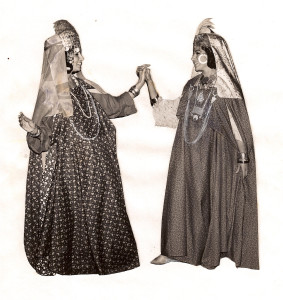
After reading “Flute of Sand,” Lawrence Morgan’s book about the Ouled Naïl, Aisha says, “It sounded so familiar at first that I got upset, thinking he had gleaned his information from my articles and workshop lectures, but I soon realized I was being paranoid. He has given a pretty good portrayal depicting their human side as well as their mystique in a very personal recollection. Of course, we don’t really know how the Nailiyat felt about him. We can only hear his side of the story.”
A few key dance adventures
Thank goodness Aisha is working on her memoirs because I’m having a hard time keeping this internet-length. But I asked her for some of her favorite memories. Here are a few direct quotes:
“Floating down the Nile in the middle of the night on the ferry boats with Abu Kharage and the Banat Mazin, once we had left the tourists ashore. With the motor turned off, the water created a perfect sound studio and this was when I recorded many of the pieces on my first album ‘Music of the Ghawazee’ which is so soulful and stimulating.”
“I enjoyed performing to live music in night clubs for close to 40 years. The admiring audiences gave me a sense of purpose and fed my ego.”
“Whenever I was in Cairo, on Thursday nights I would watch the rooftops for colored lights. If there were lights I knew there would be a wedding celebration going on and I often crashed the parties. Because I was a girl carrying a large camera, families would welcome me and move their friends so that I would have a seat up front for the entertainment. Then they fed me and some gave out boxes of party favors. I attended celebrations for couples from all walks of life. They were all different and the dancers were wonderful.”
“The most exciting moment was when I performed at the Municipal Theater in Tunisia for their Independence Day. I was the only dancer, but I had two orchestras, one folkloric and one sharqi. The old style auditorium was large and had balconies. People threw roses on the stage as I danced, and it was breathtaking. My friend, a Tunisian engineer, was supposed to record it for me on my Uher Report L, but he didn’t know how to use it and the music was distorted”
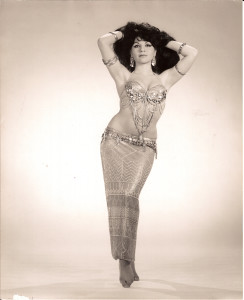
“I have had countless exhilarating experiences on stage, but one of the best was when hired in Germany by the city of Nuremberg to perform at a festival held for the local Gypsies, Arabs, and Turks. At the time, I was in my fifties, although the posters of me plastered around the area displayed a photo taken in my middle twenties. I was hiding at the back of the outdoor raised stage waiting to be announced and worrying that the audience would be disappointed when they discovered I was not in my twenties, when suddenly a group of young Jordanian boys ran up to me chanting my name. They lifted me into the air and carried me before the cheering crowd and set me on the stage. As I danced at least a dozen little girls from the audience settled down at the foot of the stage with faces propped in their dainty hands, staring at me with rapt attention. I felt totally appreciated.”
Change resisted
I’ve read about American Cabaret dancers being criticized after their friends returned from Egypt, but this is the first time I’ve heard about the dancer who made the trip experiencing resistance once she returned to the States.
After her second trip in 1973, Aisha found a lot of her dance style had changed. She’d spent much of her time watching and working with a group that performed at Sahara City, a cabaret tent near the pyramids.
“Dancers on the West Coast didn’t know what to think about the minimalist movements to more subtle music. At that time, music in most U.S. clubs was primarily Turkish and Greek. It was like a gallop,” Aisha says, “which meant dancing was made up of shimmies with turns, spins, the choo-choo, and Turkish drops or backbends and a dancer was considered good if she was very fast and then very slow for the taksim”
Aisha asked the local LA musicians to learn from her recordings, but they were unable to cooperate. “By then I was doing subtle undulations and responding to the nuances in the music. The local music seemed uninspired and repetitious and after experiencing the real thing, it no longer excited me.”
Persuading club owners to change proved a challenge. “Since the musicians were often from various Middle Eastern countries, each played their own version of Egyptian music, which came out more like neighborhood hafla music, not what you’d hear from professional musicians in a Middle Eastern nightclub”.
After showing her Ghawazi dance footage shot on 8mm film, Aisha overheard some dancers in Oregon commenting:
“Did you see those plump women and what they were doing? Are we supposed to dance like that?” Despite playing finger cymbals regularly, most American students couldn’t keep up with the tempo of the tab’l baladi, which usually accompanies a mizmar band.
However, being able to perform these dances allowed Aisha to offer something different and to develop the subtleties and nuances of raqs sharqi, which is why her troupe was brought to London. Working with the Lebanese drummer John Kannan from London’s original Omar Khayyam was a learning experience. “Formerly the drummer for Nadia Gamal, his technique was precise and professional and he actually watched and followed the movements of each dancer so that there was an exchange between artists.”
After living and working in London, Aisha continued traveling regularly to various Middle Eastern countries over a period of 25 years, staying a month or two at a time. With experience and after learning more Arabic, she began moving around freely, visiting Egypt, Lebanon, Syria, Libya, Algeria, Tunisia, and Morocco as well as Turkey. She never got to the Arabian Gulf but in the 1980s a group of Kuwaiti male dancers and musicians came to Los Angeles. After learning their Khaliji dances, she and her dance company, performed with them at UCLA, USC, and UCRiverside.
Samia Gamal’s advice
During 1971 when she was being coached by Samia Gamal, Aisha was disappointed that Samia would never dance with her. “She showed up wearing a sheath dress with nylons and would stand to watch me, telling me what I was doing wrong. Mostly she would nag me to keep my arms raised but she guided me to get rid of any American mannerism I had picked up. Suad, of the Banat Mazin, also stressed keeping the arms raised when I danced with them.
“Middle Eastern people generally lift their arms when they dance. Even if they are not a dancer, they will stand and lift their arms high, which signals a feeling of exhilaration and moves a different part of your body.”
Aisha feels that today there is too much emphasis on technique alone. We should not bring our technique drills to the stage. She would prefer to see more subtle articulation of the chest, for example, raising the chest on an accent without lifting the shoulders or tightening the back.
Still, she admits that when judging for the Belly Dancer of the Universe Competition, she finds there are many accomplished dancers, both local and international, who have the right feeling.
Ideal dancer
As we learn, I think that we have an ideal dancer in our heads. We see someone and long to move our bodies like them. So I asked Aisha how that ideal dancer in her head shifted with her travels.
Aisha says it’s hard to remember when that image actually shifted. She tries to discover traces of her old style while watching some of her students who studied with her 35 or 45 years ago and have come back to dance with her after a marriage, divorce or their kids growing up. Sometimes she can see remnants of her early style in their movements.
But she returned to Zanouba as her ideal:
“Zanouba had intense feelings for the music and for the musicians. She would dance to each one to make him feel special and create a call-response action with her body answering either the melodic lines or the rhythm. Her movements were always elegant and she was beautifully costumed and made up to perfection. Like a geisha, her purpose was to make herself beautiful and share the experience of her performance with the audience.”
Respect for the dance
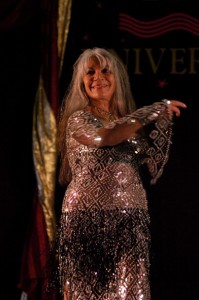
Aisha’s been introduced as a “national treasure” by Peter Sellars at the Los Angeles Festival, she’s been invited to speak at prestigious universities across the United States and has travelled the world representing the dance in international festivals and concerts. Since I continually see the theme of respect turning up on the internet and in conversation with dancers, I asked her what advice she might have for dancers looking to garner greater respect for their art form. Here’s what she had to say:
“Be diligent about researching costumes, music and movement. It’s important if you want to be credible and taken seriously. You must earn the respect of the community the culture belongs to if your goal is to preserve that tradition. If you prefer being more creative and modern, you may do whatever you like, as long as it’s labeled as such, but when you are representing a culture, be faithful to it. Don’t mislead your audience because you would not be preserving culture, you would be corrupting it.”
PRACTICAL QUESTIONS
How often do you practice? In my youth, I rarely practiced because I was performing every night. Later when I had my dance company I had to create choreographies and rehearse with the group, so we practiced the routines two or three times a week. These days I perform mostly solos and enjoy the spontaneity of letting the music decide how I will move. I get practice when I am teaching my regular classes or when I am just dancing on my own whenever I hear music.
What’s a regular session look like? My weekly classes are my regular sessions and I always play a variety of music from various regions of the Arab World. It gives us a good workout because each style concentrates on different groups of muscles.
What is the best piece of dance advice you ever received and who gave it to you? “Smile honey!” is what many of the patrons at The Fez would say to me early in my career. In the beginning I always had a serious expression. An authentic smile can make up for a lot of inexperience or a limited repertoire.
If you could whisper one piece of advice in every dancer’s ear, what would it be? Enjoy yourself and never worry about how many movements you remember. If you have prepared yourself, the music will guide you and the movements will flow from your subconscious.
STUDY WITH AISHA
If you’re in LA, you can attend regular classes or sign up for private sessions. She also offers various workshops.
MUSIC AND DVDS
You can purchase DVDs that include documentaries with footage from Aisha’s field work as well as performance and instructional videos. Her well-known classic field recordings – first released on LPs – are now available on CD.
MEMOIR IN PROGRESS
Please feel free to encourage Aisha to write regularly. I can hardly wait until her memoir comes out.
Know of a belly dancer who needs her (or his) story told? Once a month, I’m blogging about dancers from the 1970s (and earlier) with the goal of educating and expanding an audience for this incredible dance form. The selection process is entirely subjective. Please send suggestions to jcobrienbooks@gmail.com. I also write supernatural noir, urban fantasy and horror. You can check out my fiction here (and yes, there is a belly dance book in the works).